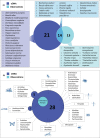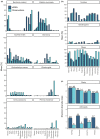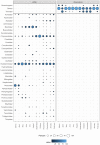Focal vs. fecal: Seasonal variation in the diet of wild vervet monkeys from observational and DNA metabarcoding data
- PMID: 36203642
- PMCID: PMC9526031
- DOI: 10.1002/ece3.9358
Focal vs. fecal: Seasonal variation in the diet of wild vervet monkeys from observational and DNA metabarcoding data
Abstract
Assessing the diet of wild animals reveals valuable information about their ecology and trophic relationships that may help elucidate dynamic interactions in ecosystems and forecast responses to environmental changes. Advances in molecular biology provide valuable research tools in this field. However, comparative empirical research is still required to highlight strengths and potential biases of different approaches. Therefore, this study compares environmental DNA and observational methods for the same study population and sampling duration. We employed DNA metabarcoding assays targeting plant and arthropod diet items in 823 fecal samples collected over 12 months in a wild population of an omnivorous primate, the vervet monkey (Chlorocebus pygerythrus). DNA metabarcoding data were subsequently compared to direct observations. We observed the same seasonal patterns of plant consumption with both methods; however, DNA metabarcoding showed considerably greater taxonomic coverage and resolution compared to observations, mostly due to the construction of a local plant DNA database. We found a strong effect of season on variation in plant consumption largely shaped by the dry and wet seasons. The seasonal effect on arthropod consumption was weaker, but feeding on arthropods was more frequent in spring and summer, showing overall that vervets adapt their diet according to available resources. The DNA metabarcoding assay outperformed also direct observations of arthropod consumption in both taxonomic coverage and resolution. Combining traditional techniques and DNA metabarcoding data can therefore not only provide enhanced assessments of complex diets and trophic interactions to the benefit of wildlife conservationists and managers but also opens new perspectives for behavioral ecologists studying whether diet variation in social species is induced by environmental differences or might reflect selective foraging behaviors.
Keywords: DNA metabarcoding; diet estimation; environmental DNA; method comparison; primates; seasonal variation.
© 2022 The Authors. Ecology and Evolution published by John Wiley & Sons Ltd.
Conflict of interest statement
The authors note that PT is co‐inventor of a patent related to the Sper01 primers and the use of the P6 loop of the chloroplast trnL (UAA) intron for plant identification using degraded template DNA. This patent only restricts commercial applications and has no impact on the use of this locus by academic researchers.
Figures







References
-
- Arseneau‐Robar, T. J. M. , Taucher, A. L. , Schnider, A. B. , van Schaik, C. P. , & Willems, E. P. (2017). Intra‐ and interindividual differences in the costs and benefits of intergroup aggression in female vervet monkeys. Animal Behaviour, 123, 129–137. 10.1016/j.anbehav.2016.10.034 - DOI
-
- Barrett, A. (2005). Foraging ecology of the vervet monkey (Chlorocebus aethiops) in mixed lowveld bushveld and sour lowveld bushveld of the blydeberg conservancy, Northern Province, South Africa. University of South Africa.
-
- Barrett, A. (2009). Spatial and temporal patterns in resource dispersion and the structure of range use and co‐existence in a social omnivore Chlorocebus aethiops. Ph.D Dissertation. University of South Africa.
LinkOut - more resources
Full Text Sources

